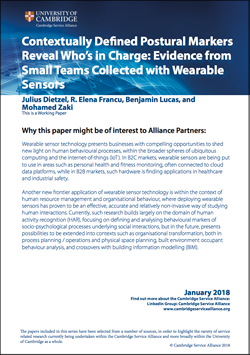
Submitted by Angela Walters on Mon, 29/01/2018 - 12:47
Contextually Defined Postural Markers Reveal Who’s in Charge: Evidence from Small Teams Collected with Wearable Sensors
by Julius Dietzel, R. Elena Francu, Benjamin Lucas, and Mohamed Zaki
Wearable sensor technology presents businesses with compelling opportunities to shed new light on human behavioural processes, within the broader spheres of ubiquitous computing and the internet-of-things (IoT). In B2C markets, wearable sensors are being put to use in areas such as personal health and fitness monitoring, often connected to cloud data platforms, while in B2B markets, such hardware is finding applications in healthcare and industrial safety. Another new frontier application of wearable sensor technology is within the context of human resource management and organisational behaviour, where deploying wearable sensors has proven to be an effective, accurate and relatively non-invasive way of studying human interactions. Currently, such research builds largely on the domain of human activity recognition (HAR), focusing on defining and analysing behavioural markers of socio-psychological processes underlying social interactions, but in the future, presents possibilities to be extended into contexts such as organisational transformation, both in process planning / operations and physical space planning, built environment occupant behaviour analysis, and crossovers with building information modelling (BIM).



